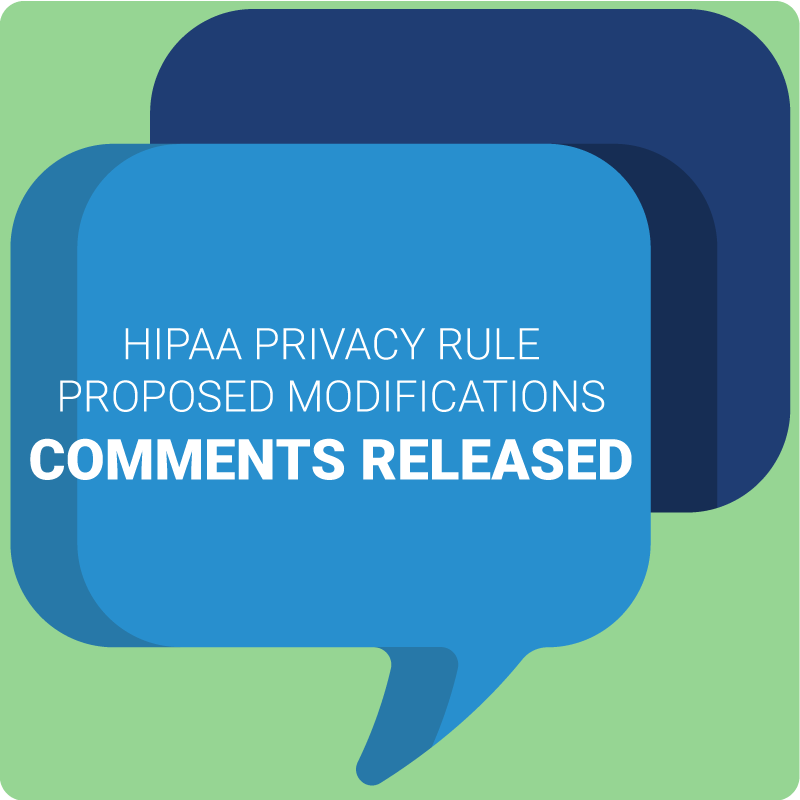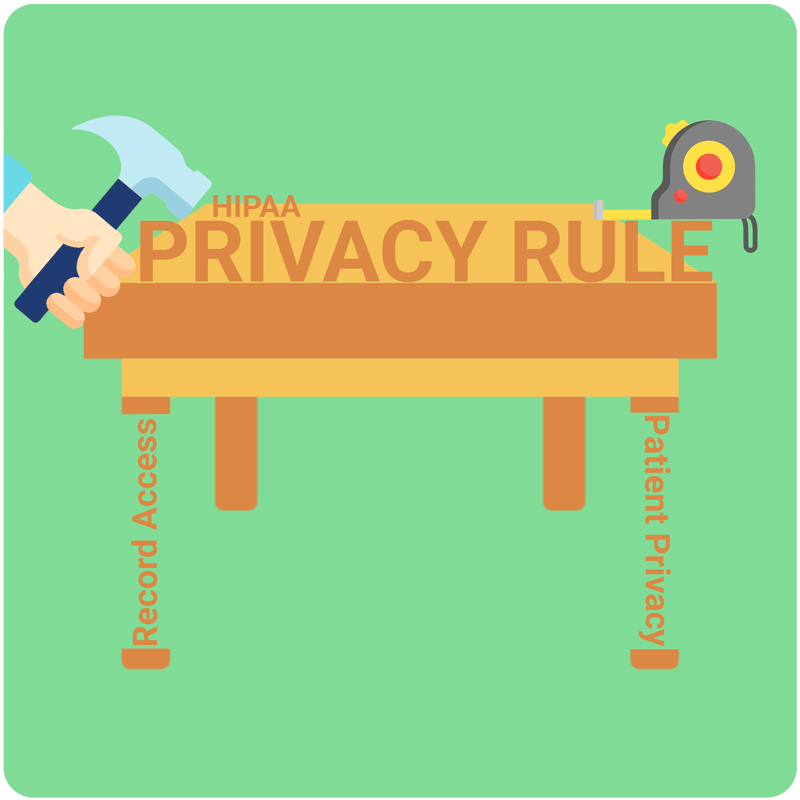July 8, 2021 Remember those Privacy Rule modifications that the Department of Health and Human Services (HHS) proposed late last year? Well, after adding a 45-day extension on the public comment period back in March, the responses submitted have finally been made available – giving us some additional insight on what we can expect to see when the updates are officially finalized. For anyone looking for a light-read while they drink their morning coffee – diving into the official HHS document might not be for you. The proposal included a lengthy list of changes centered around increasing permissible disclosures of protected health information (PHI) and enhancing care coordination and case management. As the healthcare industry has evolved, so have the necessary requirements for protecting data privacy and security – and these modifications address several issues that have become the source of widespread non-compliance over recent years. One of the major areas of focus should come as no surprise considering the initiative that was declared in 2019 to enhance enforcement for patient right of access violations – and the 19 different settlements that have resulted from it so far. So in looking at how the Privacy Rule changes plan to improve this issue, some of the major proposed provisions include: In addition to addressing patients’ right of access, the proposed modifications also clarify certain definitions and phrasing that oftentimes leads to confusion and misunderstanding by providers and patients. Some of these updates include: While the examples provided are only a snapshot of the full list of proposed modifications, each update follows suit with the evolving environment in the healthcare industry and covers relevant concerns felt by both providers and patients. So much so, that the comment period extension was made due to such a “high degree of public interest” and amounted to a total of 1,391 comments submitted in response to the HHS’s proposal. So what can we expect? These proposed modifications take into consideration the public comments received on the OCR’s 2018 RFI that requested public input on how HIPAA rules could improve to better “support care coordination and case management and promote value-based care while preserving the privacy and security of PHI.” Each provision is a direct reflection of the key themes identified in the public opinion received back in 2018 and addresses issues like administrative burdens and the need for improving upon patient rights. So although we don’t have a time machine to jump ahead and see what exactly the final rule will entail, we can pretty confidently say that these concerns addressed in the HHS document will continue to be a focus in regulatory amendments and government enforcement. And the high volume of public interest clearly depicts the impact and value that enacting these changes will have on patients and providers. When will you need to comply As far as knowing the what and when of the final ruling – we don’t quite have a definitive answer. But it’s important for all covered entities to be aware and prepared for the expectations of complying with the modified Privacy Rule provisions when they are made official. According to the HHS, “The effective date of a final rule would be 60 days after publication.” Additionally, entities will still have 180 days from that effective date to update or implement policies and procedures to achieve compliance with these new standards. So when it comes to the timeframe for when the government will actually start enforcing the new compliance standards, you have 240 days of breathing room once the final rule is published. BUT based on the HHS’s acknowledgment that the impact of adhering to these new guidelines will involve “covered entities actions to re-train their employees on, and adopt policies and procedures to implement, the legal requirements of this proposed rule” we highly recommend taking an ‘early bird gets the worm’ approach for compliance. Having a complete HIPAA program in place along with a full understanding of the potential changes that could be coming your way is the best way to ensure that your patients’ data is best protected and your practice is best prepared for avoiding a HIPAA violation and fine.
Comment Period Extended for Proposed HIPAA Privacy Rule Modifications
March 11, 2021 HIPAA law is officially getting with the times thanks to the proposed Privacy Rule modifications that are giving the “prehistoric law” a new modernized look. While the planned updates were officially announced last December, the Department of Health and Human Services (HHS) has just added a 45-day extension on the comment period – giving the public some more time to weigh in on what they want they want the updated legislation to cover. The original HIPAA Privacy Rule came on the scene in 2003 – you know, like when disposable cameras and listening to Shake Ya Tailfeather by Nelly on your iPod were cool? With as much as technology has changed the world around us, it only makes sense that the laws governing data protection follow suit. Especially since they haven’t changed since being created in the “stone-ages.” The new proposed changes go hand-in-hand with the evolving needs of patients and providers to address the issues of patient right of access and “unnecessary regulatory burdens.” Each of these have proven to be trending areas of focus in recent OCR enforcement efforts with three out of the four settlements announced in 2021 resulting from right of access complaints. But improving patient rights and boosting care coordination isn’t only in the government’s best interests, “OCR anticipates a high degree of public interest in providing input on the proposals because the HIPAA Privacy Rule affects nearly anyone who interacts with the health care system,” Acting OCR Director Robinsue Frohboese stated in response to the recent announcement. “The 45-day extension of the comment period to May 6, 2021, will give the public a full opportunity to consider the proposals and submit comments to inform future policy.” Now, we know what you’re probably thinking – is there really a high degree of public interest over HIPAA???? While the idea might come as a bit of a surprise – the major spike in patient complaints, data breaches, and government enforcement seen over just the past year have given the law some new-found fame. And since everyone loves a good comeback story, this HIPAA revival has proven that staying up on the latest and greatest in regulation changes is worth keeping on your radar. So, even though the new extension buys you some more time to comply with the proposed updates – it’s never too early to meet mandatory HIPAA requirements. Unfortunately, the reality is that most practices today would need to perform an excavation, chiseling through mountains of dust, to bring their HIPAA compliance program out of the dark ages. If your compliance program resembles something that hasn’t been touched since Tom ruled MySpace, getting up with the times is not an option and upgrading to an electronic HIPAA solution is the perfect place to start. Want to put in your ‘two cents’ on the proposed Privacy Rule updates? Just visit the Federal Register to read the official rule proposal and submit your comments!
OCR Announces 2nd HIPAA Settlement of 2021 with Health Insurer for $5.1 Million
January 15, 2021 Buckle your seatbelts – it’s only 15 days into 2021 and it’s already looking like this year will be a wild ride when it comes to HIPAA enforcement. The Office for Civil Rights (OCR) just announced another HIPAA settlement (and a doozy at that), bringing in not one but TWO fines just this week. The latest (and greatest) HIPAA fine of 2021 was just awarded to Excellus Health Plan, Inc., a health insurance provider serving over 1.5 million people in New York. The settlement includes a whopping $5.1 million fine and a 2-year corrective action plan, the result of cyber attack affecting more than 9 million records along with a slew of other HIPAA Privacy and Security Rule violations. Fun fact: the OCR didn’t reach $5 million in total fines levied until September of last year, and today’s announcement means they’ve already exceeded the $5 million mark just 15 days into 2021 – talk about starting the year off strong! Excellus’ story all started when the OCR received a breach report on September 9, 2015 that cyber-attackers had gained access to Excellus Health Plan’s information technology systems. Of note with this particular breach story is that the hackers in Excellus’ case were accessing their systems so long, they not only set up shop but practically built a whole mall to go with it – hanging out in the health plans’ database from December 23, 2013 allllll the way until May 11, 2015 – an entire year and a half. Their overextended stay allowed the hackers to install malware in addition to other malicious activities that provided unauthorized access to the protected health information (PHI) of over 9.3 million individuals – improperly accessing everything from names, to addresses, social security numbers, financial information and clinical treatment information. If having hackers in your IT system for almost 2 years wasn’t bad enough, the OCR also found that Excellus had violated some pretty important HIPAA rules, including: As a great example of what NOT to do when it comes to your HIPAA and technical security programs, today’s fine also offered words of wisdom from the OCR: “Hacking continues to be the greatest threat to the privacy and security of individuals’ health information. In this case, a health plan did not stop hackers from roaming inside its health record system undetected for over a year which endangered the privacy of millions of its beneficiaries,” said OCR Director Roger Severino. “We know that the most dangerous hackers are sophisticated, patient, and persistent. Health care entities need to step up their game to protect the privacy of people’s health information from this growing threat.” One positive when it comes to increasingly concerning cyberthreats? The recently passed HIPAA Safe Harbor Bill offers your practice the chance to receive smaller HIPAA fines (even more important with the whopping $5.1 million precedent just set) IF you have the necessary safeguards in place 12 months BEFORE a cyber event. Even though data breaches and hacking incidents aren’t always in your control, practice’s preparation beforehand is – and could mean the difference between a smaller, manageable fine and ranking among the top 10 greatest hits on the OCR’s fine list.
HIPAA Building Blocks: The Privacy Rule
November 24, 2020 Implementing a complete HIPAA program is kind of like assembling a piece of furniture from IKEA – there’s lots of different pieces and little direction when putting it all together. Even if you’re a master IKEA-assembler, HIPAA is a whole extra level of confusion, and breaking it down into the basics can help make things a little less stressful. The first step in building a complete HIPAA compliance program is to start with the base – the HIPAA Security Rule. Once you have a sturdy foundation made up of all of the proper documentation and required safeguards, it’s onto step number two: otherwise known as the HIPAA Privacy Rule. Many of the nuts and bolts of HIPAA law are built into the HIPAA Privacy Rule, which provides strong privacy protections to safeguard sensitive patient information and ensure patients have proper access to their own medical records. Thanks to the Privacy Rule: Record access and privacy are the basic goals behind the Privacy Rule, but the second piece of the rule includes an extensive list of ongoing compliance requirements, such as: Just like opening up that new box from IKEA, taking on a complete HIPAA compliance program can feel overwhelming. However, Privacy Rule complaints continue to roll in to the Office for Civil Rights (OCR) and patient right of access violations have become an increasing point of OCR focus since 2019 – making compliance with the Privacy Rule a top HIPAA priority. Now unless you’re a DIY enthusiast, you might opt for new furniture that doesn’t come in a 1,000 different pieces. Choosing a pre-assembled option instead saves you time, energy, and headaches – and the same can be said of HIPAA. Choosing a HIPAA compliance software like Abyde lets you fill in a few quick areas to get your program up to speed, instead of having to build each piece from scratch. In less than an hour, and with far less headaches, you can get everything you need to be compliant, and so much more. The best part? There’s no need for an instruction manual – Abyde has real people ready and waiting to help walk you through the process and make sure you aren’t missing any important pieces (like finding that missing screw from step 7 on step 28) along the way.
Should I Share This? When Sharing PHI is HIPAA Approved
June 18, 2020 We get it, the struggle is real. The moans and groans with HIPAA always seem to get louder when medical practices are faced with figuring out to whom and how sensitive data can be shared. Contrary to what many believe, HIPAA is all about properly sharing protected health information (PHI) – not preventing it entirely. Sometimes, lacking confidence that internal policies are in alignment with best practices on sharing PHI securely can cause a practice to hesitate to (or altogether not) send PHI to other parties requesting it, including other providers. Unfortunately, not acting in a timely manner and failing to comply with the request to share PHI with another provider can be a costly one. Proper disclosure of PHI is highly regulated under HIPAA when it comes to sharing or receiving patient records from another practice, and there are consequences to both sharing too much information – or not enough. First, the HIPAA Privacy Rule does in fact permit a health care provider to share patient information for treatment and healthcare operation purposes without needing written patient authorization as long as the reasonable safeguards to protect the information are used. To clarify what the U.S. Department of Health and Human Services (HHS) considers as treatment and operation purposes, “Treatment means the provision, coordination, or management of healthcare and related services by one or more health care providers, including the coordination or management of health care by a health care provider with a third party; consultation between health care providers relating to a patient; or the referral of a patient for health care from one health care provider to another.” Some key notes on sharing PHI between providers: Additionally, if a patient is the one requesting their records to be sent to another provider: It’s time for providers to change their perspective on HIPAA – which is widely considered a restrictive set of laws and regulations. HIPAA is meant to be a guideline on how to securely and efficiently share sensitive and valuable data. Not a barrier or inhibitor as so many see it now. Being able to do so will have positive effects on the healthcare industry as a whole and improve patient care for years and years. Don’t let the unknowns of HIPAA keep data from those who have lawful access to them such as other providers or patients. If so, it is just as much of a HIPAA violation as sharing sensitive data with the wrong people.




